Nurturing Future Leaders
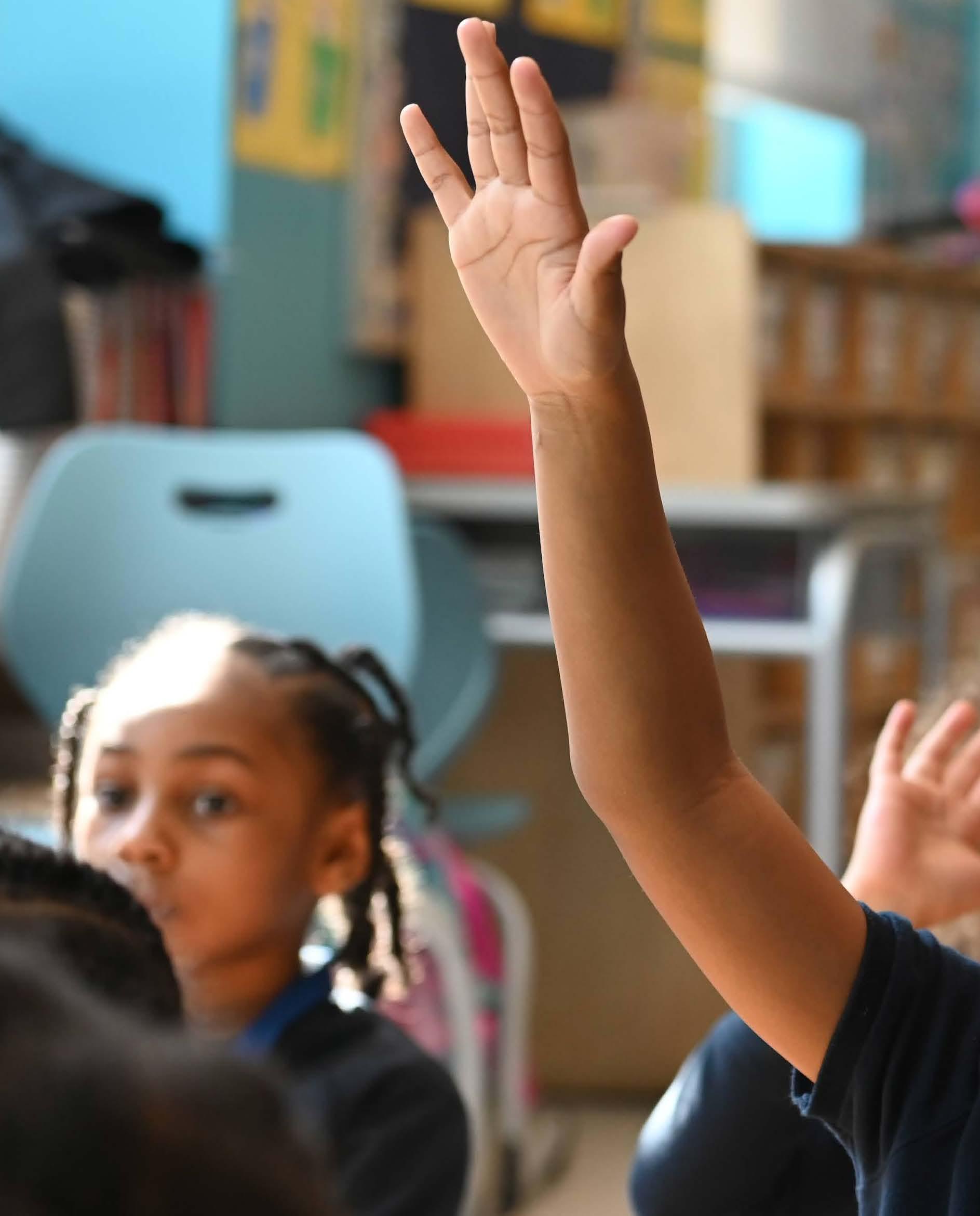


Harlem Academy inspires excellence with a rigorous curriculum wrapped in a joyful and ethical school culture. We foster confidence by setting up real challenges, nurturing talent, and supporting students in meeting their individual goals. We work with focus and determination but take time to celebrate each other’s achievements and share in life’s special moments.


When you push yourself and never give up, like the School Creed says, the reward is big!”
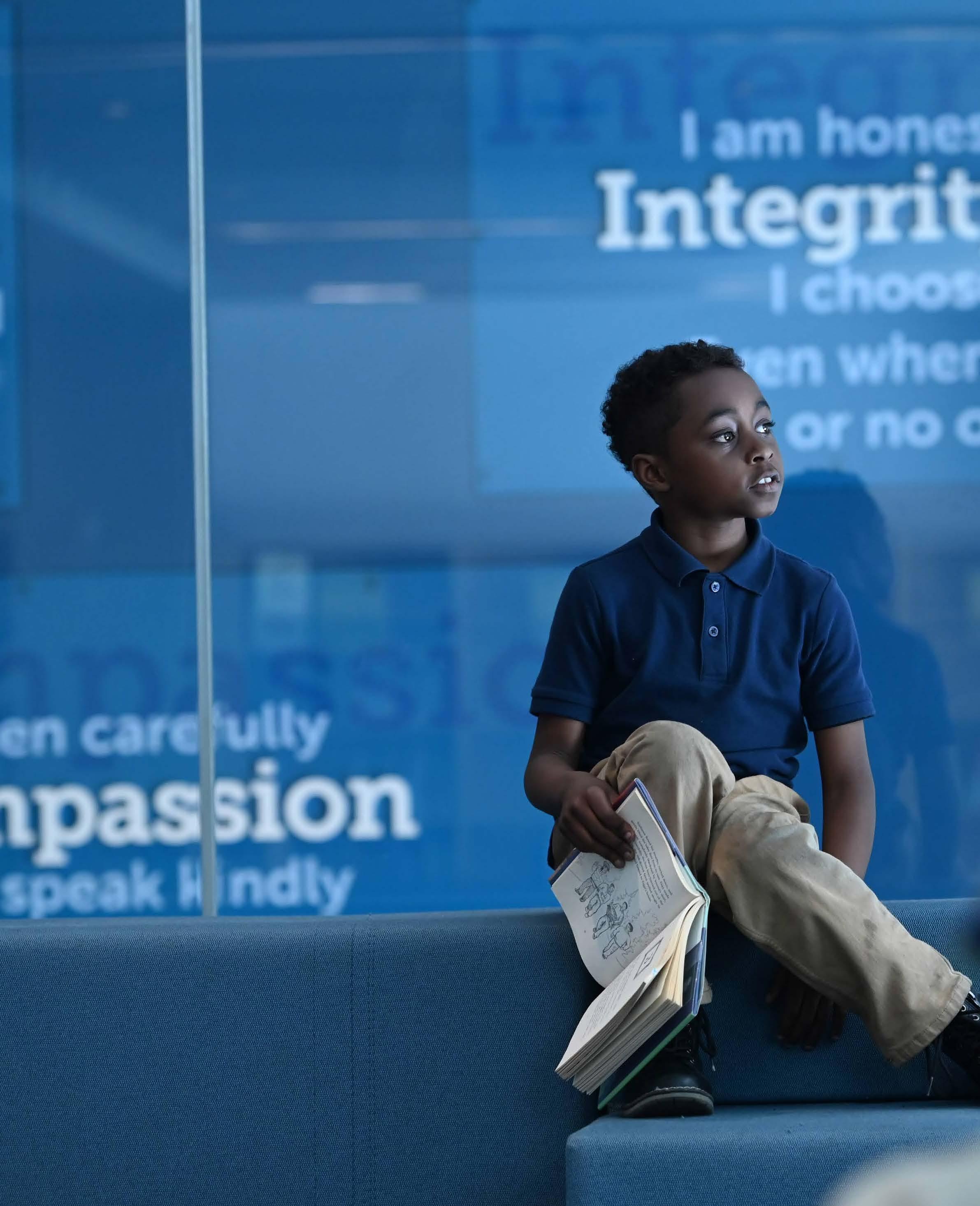
Character education at Harlem Academy is rooted in our School Creed and four community pillars: initiative, integrity, compassion, and determination. Students learn the Creed as kindergartners, carrying it with them as they grow. It serves as a foundation for reflection and improvement, a catalyst for discussion in advisory and community meetings, and a touchpoint for daily lessons across academic subjects.


Our weekly community meetings bring each division together to explore the Creed and pillars in meaningful ways. Meetings are anchored by a reading, story, or activity that emphasizes values and habits critical to students’ success. A cherished tradition during these meetings is the presentation of commendations, where teachers recognize a student’s action that exemplifies the pillars or demonstrates growth. This positive recognition reinforces our values and sets an example for other students. Community meetings also include recitations of our School Thanksgiving and Creed, guided mindfulness, and informal greetings.
At every stage of their journey, students are encouraged to reflect on who they are and hope to become as individuals and community members. At the end of kindergarten, each student writes a letter to their future graduating self, reflecting on their achievements and hopes for the future. They repeat this ritual every year, culminating in a powerful moment on graduation day when the head of school hands them a bulging envelope – a tangible testament to their growth, filled with years of memories, milestones, and dreams from their younger selves.
Leadership opportunities are woven into the student experience in each division. Second graders take their first steps by helping their teachers lead a community meeting. Fifth graders take a lead role in welcoming the incoming sixth grade class, organizing activities for a memorable “Moving Up Day.”
As students transition to middle school, they embark on their first three-day outdoor adventure to a camp near the Delaware River – an experience designed to challenge them to step out of their comfort zones and build lasting connections.
In the fall, we hold a special Blazer Ceremony to recognize eighth graders' role as leaders in school and beyond our walls. Later that year, they travel to Washington, D.C. for a three-day leadership experience. Students’ final public speaking role happens at graduation when they take the podium to introduce a classmate and offer a thoughtful reflection on how they have lived the Creed.
Primary school is a formative time, when children begin to shape their identities as learners and friends. Our students become confident readers and writers and start to see themselves as future mathematicians, scientists, and changemakers. Through joyful engagement, they learn to build productive routines, express their ideas, collaborate with others, and overcome challenges.
Classes
Arrives early for optional breakfast
Morning meeting
Literacy
PE | Tennis
Lunch
Math
Recess
Science (2x/week)
Community meeting
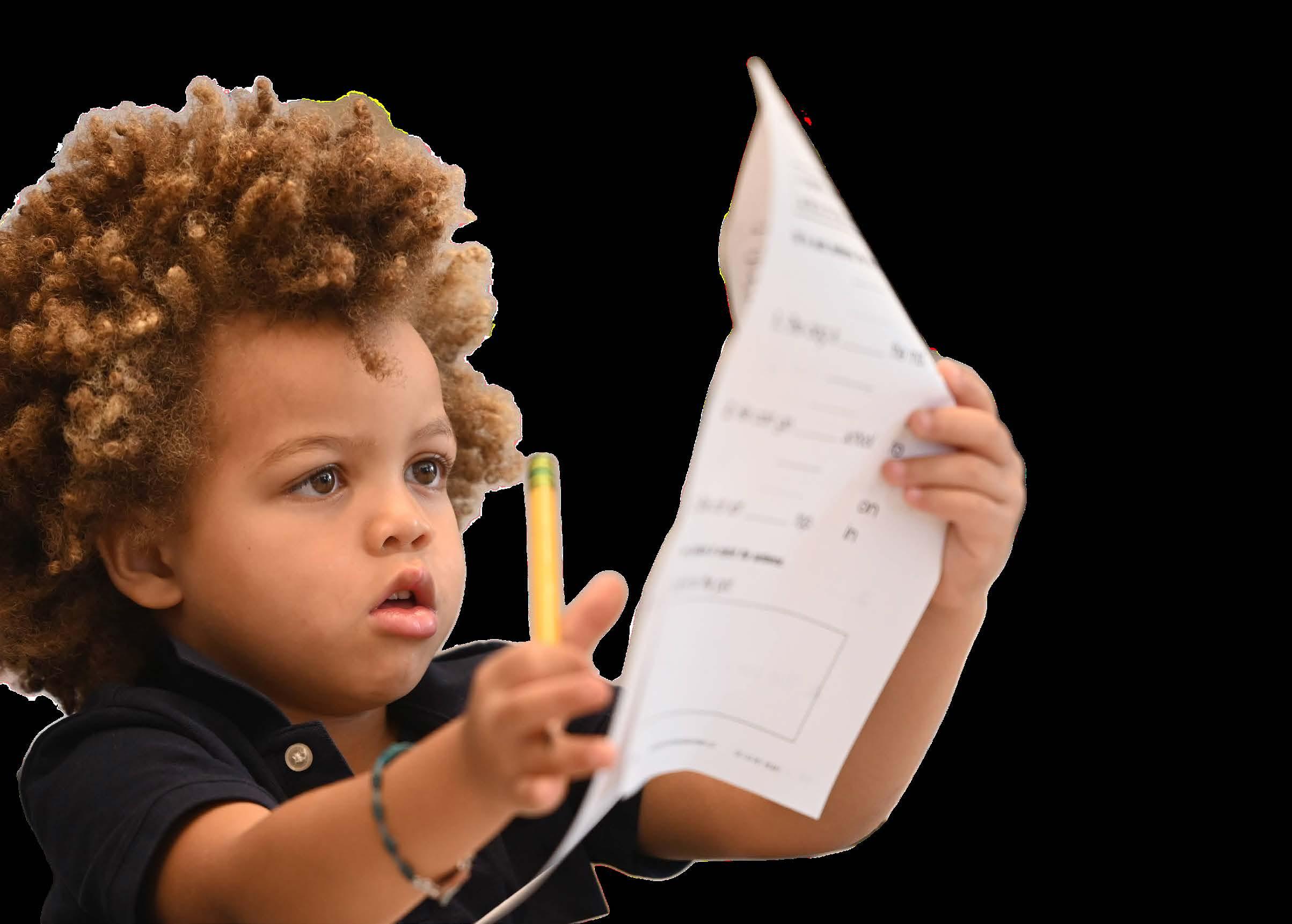
Performing arts | Dance
Visual arts | Color & form
After-School Enrichment

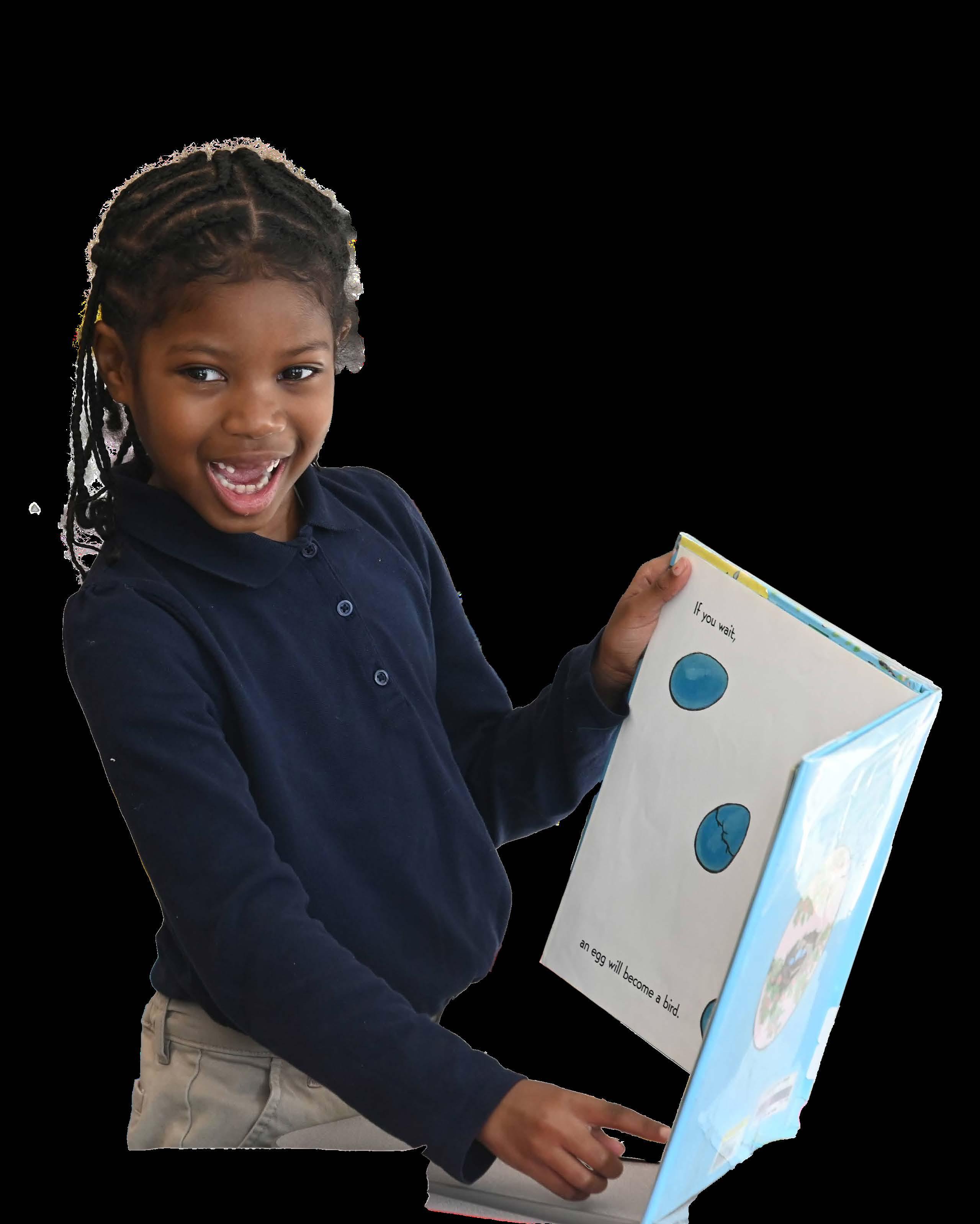
Our program includes fiction and nonfiction reading, writing, vocabulary, grammar, and phonics within integrated units. Students learn how to communicate effectively not only through writing and their first experiences with public speaking but also by developing the important skills of active listening and problem-solving. Daily read-alouds connect to our School Creed, prompt wholeclass discussions, or just bring smiles to students’ faces. Students visit the library each week to find independent reading books with the help of their classroom teacher.
We introduce new concepts through a structured progression: first with hands-on manipulatives like teddy bear counters, then with pictorial representations, and finally with abstract representations such as algorithms. Students also use IXL, an online personalized learning tool, to reinforce skills and build fluency at their own pace.
Kindergartners build foundational number sense and fluency with counting and comparing. They count to 20, develop an understanding of place value with ones and tens, and compare sets to determine which is larger. Students build an early understanding of addition and subtraction as combining and taking apart. A study of shapes and their attributes introduces students to geometry.
First graders deepen their understanding of numbers up to 100, strengthening their grasp of place value and developing fluency with addition and subtraction. They begin using standard algorithms and mental math strategies to add and subtract within 20. Students also explore measurement concepts, compare lengths and weights, and learn to organize and analyze data using pictorial and bar graphs.
Second graders expand their number sense to 1,000, gaining confidence in comparing and ordering numbers. Students use addition and subtraction strategies that require regrouping and bar models to represent and solve two-step problems. They learn multiplication using repeated addition of equal groups and multiplication facts for 2, 5, and 10. Students develop measurement skills using metric and customary systems, solve word problems involving length and mass, and extend their data analysis skills by creating picture graphs.
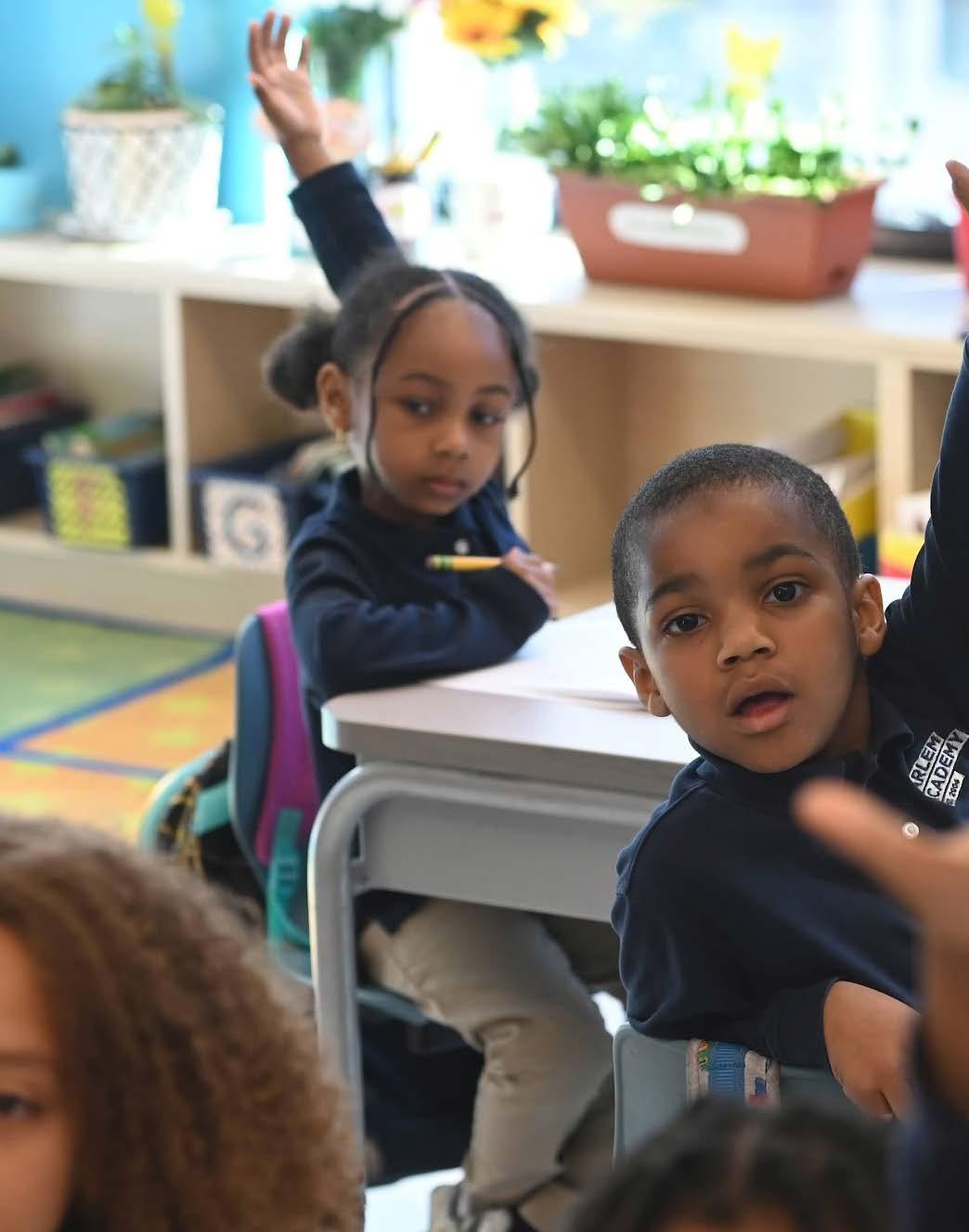
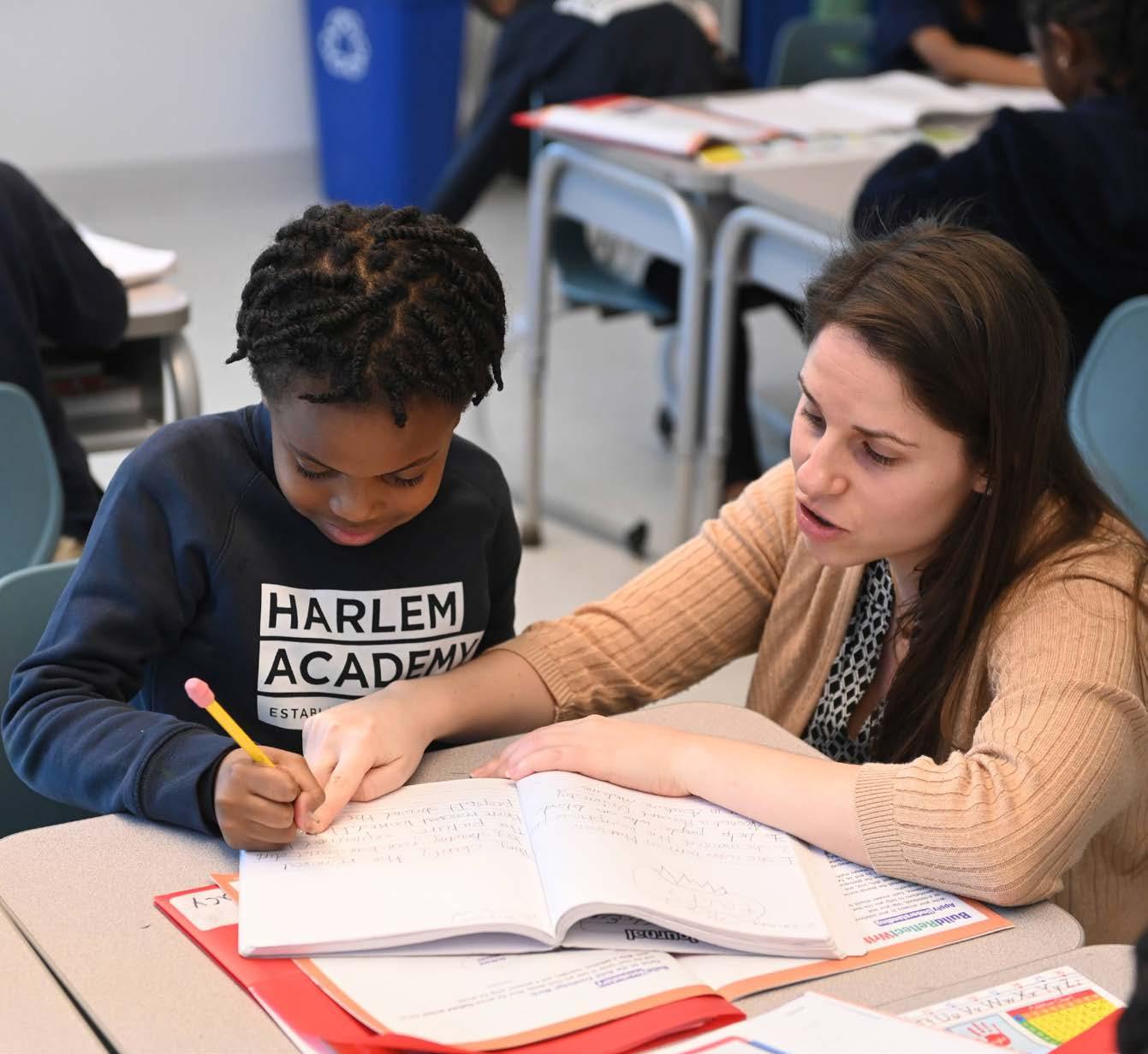

Students study physical, Earth, and life science each year using a handson curriculum. They ask and answer questions about the world around them through inquiry, investigation, and analysis.
Kindergartners start with an animal studies unit, learning about basic needs of common land and water animals while observing differences in structure and behavior. The materials and motion unit introduces the study of natural resources and how the properties of materials determine their use. In the trees and weather unit, students track daily weather changes throughout the year and examine how weather impacts living things.
First grade begins with an introduction to the scientific method, which students will use throughout their
time at Harlem Academy. In the air and weather unit, they explore the properties of air and factors influencing weather patterns. The sound and light unit engages students in hands-on exploration using musical instruments like xylophones to investigate sound. The year concludes with a plants and animals unit, where students examine how they grow and adapt to their environments.
Second graders begin the year exploring plant and animal relationships, focusing on their needs, interdependence, and interactions within ecosystems. Next, they investigate material properties, test physical characteristics, and construct evidence-based explanations about how materials perform under different conditions. The year ends with a study of how landforms change over time
I want to highlight how much growth my son has shown academically and socially. He has already established meaningful friendships. My five-year-old has become such a responsible person.”
Tanya Liriano, Parent ’33
due to natural processes like erosion and weathering, using evidence to explain these changes.
Students build confidence to express themselves verbally and in writing during two language instruction blocks each week. Using interactive activities, read-alouds, games, dancing, and arts and crafts, students expand their language skills. They learn vocabulary and grammar, with a focus on greetings, numbers, shapes, family, body parts, days of the week, seasons, months, and weather. Students also explore Hispanic and Latino cultures and traditions.
We continue to nurture a love of reading, writing, math, and science as students develop into confident, independent learners. Our elementary students deepen their understanding of the School Creed, applying its core pillars – integrity, compassion, determination, and initiative –to more complex ideas and their personal values.
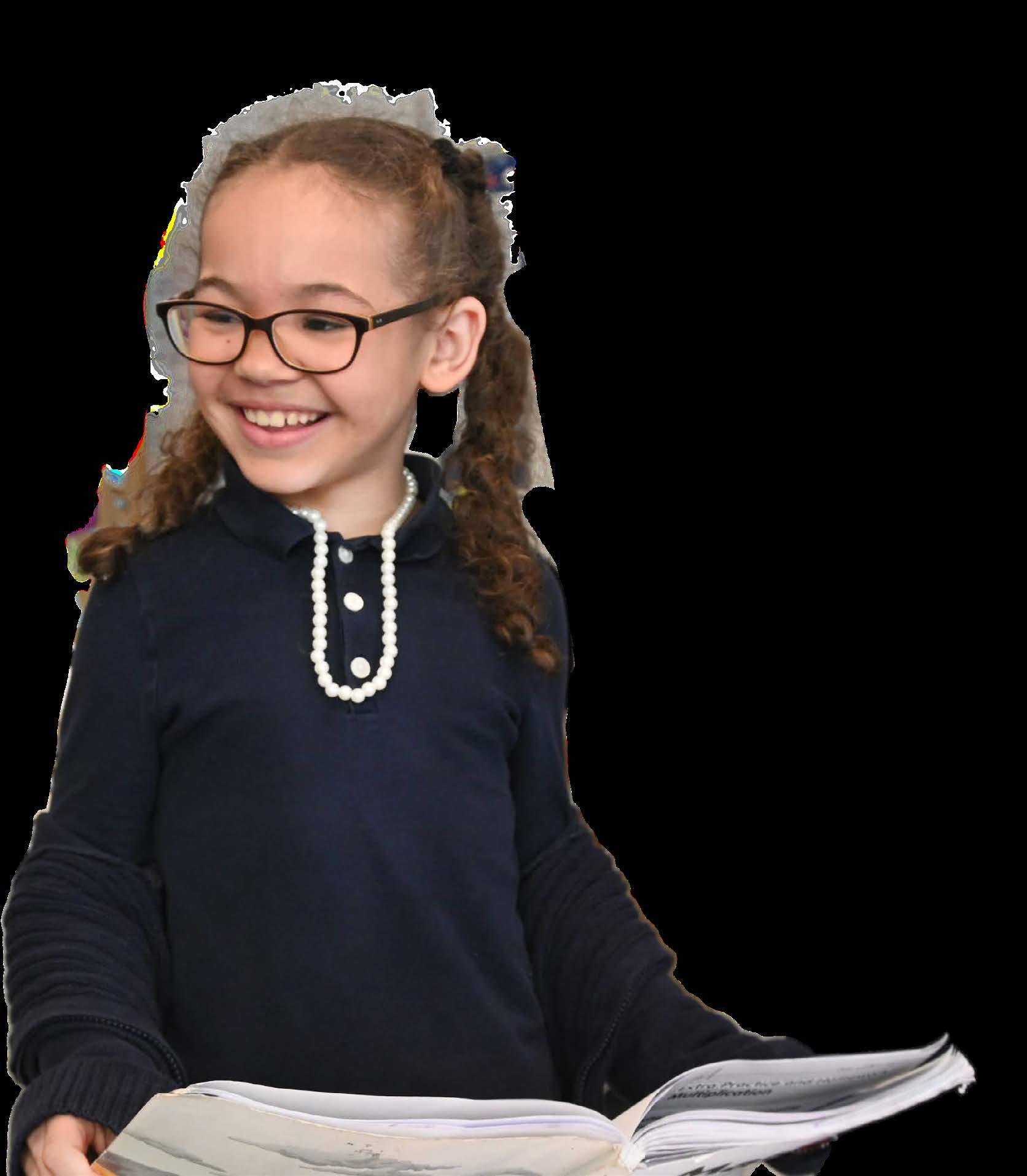
Classes
Arrives early for optional breakfast and informal soccer
Morning meeting
Literacy
Math
Recess
Lunch
Science (3x/week)
PE | Soccer (3x/week)
Advisory (1x/week)
Community meeting (1x/week)
Visual arts | Mixed media (1x/week)
Performing arts | Improv (1x/week)
Chess (1x/week)
Library (1x/week)
After-School Enrichment
Homework support
Spanish
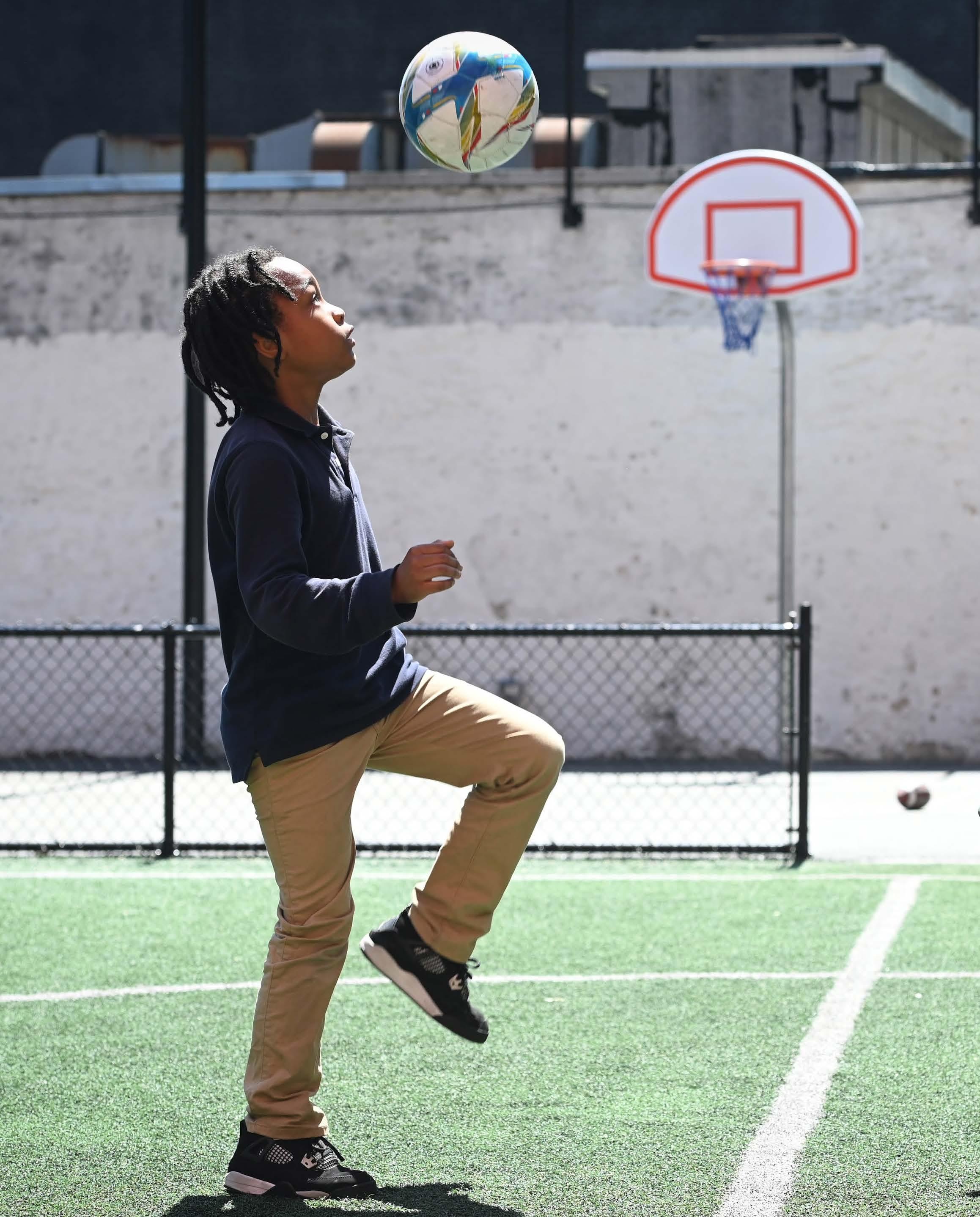
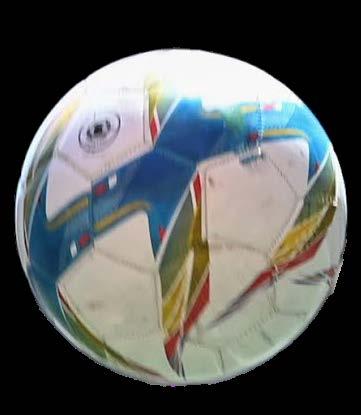
Studies piano, improv, dance, and comic illustration at Harlem School of the Arts
Takes advantage of after-school enrichment opportunities, including Spanish, sports and games, STEM, and art
Explores the scientific method through a range of experiments with a dedicated specialist
Crafts and presents their original poetry
Leads a community meeting
Delves into the rich narrative of “Esperanza Rising” by Pam Muñoz Ryan as they prepare for the rigor of middle school

By the time they complete elementary school, students have built a strong foundation in reading, writing, listening, and speaking – critical tools for long-term academic success. Each day, they dedicate over two hours to developing these skills.
Our program focuses on fiction and nonfiction reading, including a formal study of Greek and Roman history in fifth grade. As students advance through elementary school, they take on more complex writing assignments and literary analysis through novel studies, including “One Crazy Summer” by Rita Williams-Garcia.
All three grades continue to build their grammar and vocabulary knowledge, while teachers incorporate read-alouds to model strong reading habits, encourage thoughtful discussion, and celebrate an inclusive tapestry of voices, particularly Black, Latino, and other authors and characters of color. At least once a week, they visit the school library to discover new independent reading options, and you’ll often see students with a book in hand.
Our students build deep conceptual understanding and procedural fluency in numerical operations, geometry, data analysis, measurement, and problem-solving. The curriculum teaches fewer concepts with greater depth, guiding students from concrete examples to pictorial demonstrations before transitioning to abstract concepts, preparing them to tackle increasingly difficult problems.
Third graders solidify their understanding of addition and subtraction up to 10,000, mastering regrouping strategies. They explore multiplication as repeated addition of same-sized groups and division as equal splitting apart into same-sized groups and gain confidence with multiplication facts. Using bar models, they begin solving multistep multiplication and division problems. Students are introduced to fractions, placing them on a number line, comparing them, and ordering them. Geometry topics include area and perimeter. Students also extend their measurement skills by learning the metric system for mass and volume.
Fourth graders strengthen their ability to apply all four numerical operations to solve problems and work with numbers up to 100,000. They deepen

their understanding of fractions and decimals, including comparing and ordering fractions, converting improper fractions to mixed numbers, adding and subtracting mixed numbers, and solving fraction word problems using bar models. They explore the relationship between fractions and decimals and learn to compare and round decimals. In geometry, students learn to measure and classify angles and identify triangles based on their angles.
Fifth graders refine their understanding of place value, working with numbers up to 10,000,000. They extend their skills by adding, subtracting, and multiplying fractions and mixed numbers, applying bar models to solve word problems with fraction multiplication. They also add, subtract, multiply, and divide decimals, applying these skills to realworld situations. In geometry, students calculate the volume of rectangular and composite prisms. The data analysis unit introduces graphing coordinate pairs on the x-y plane and representing data using line plots.

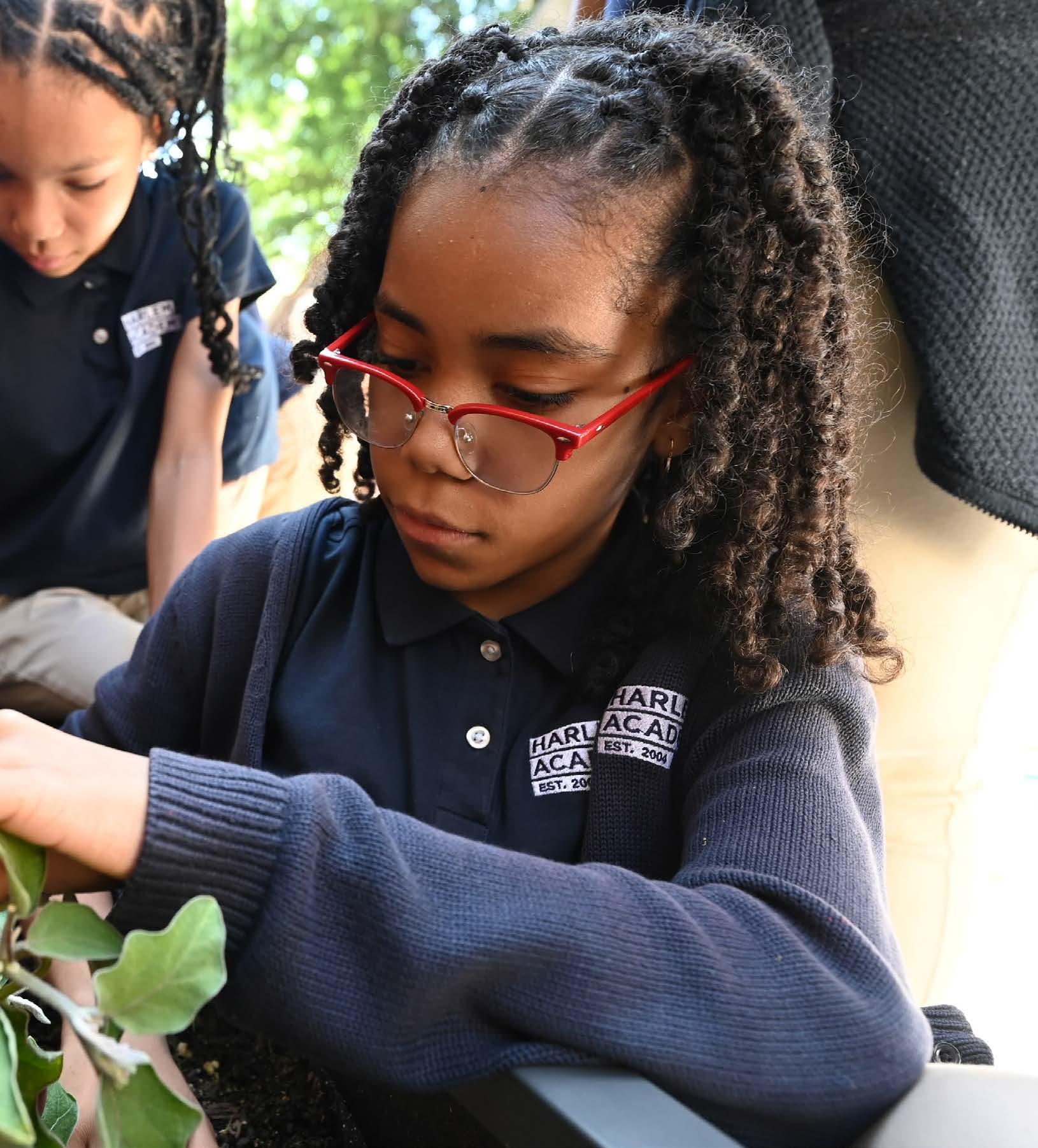
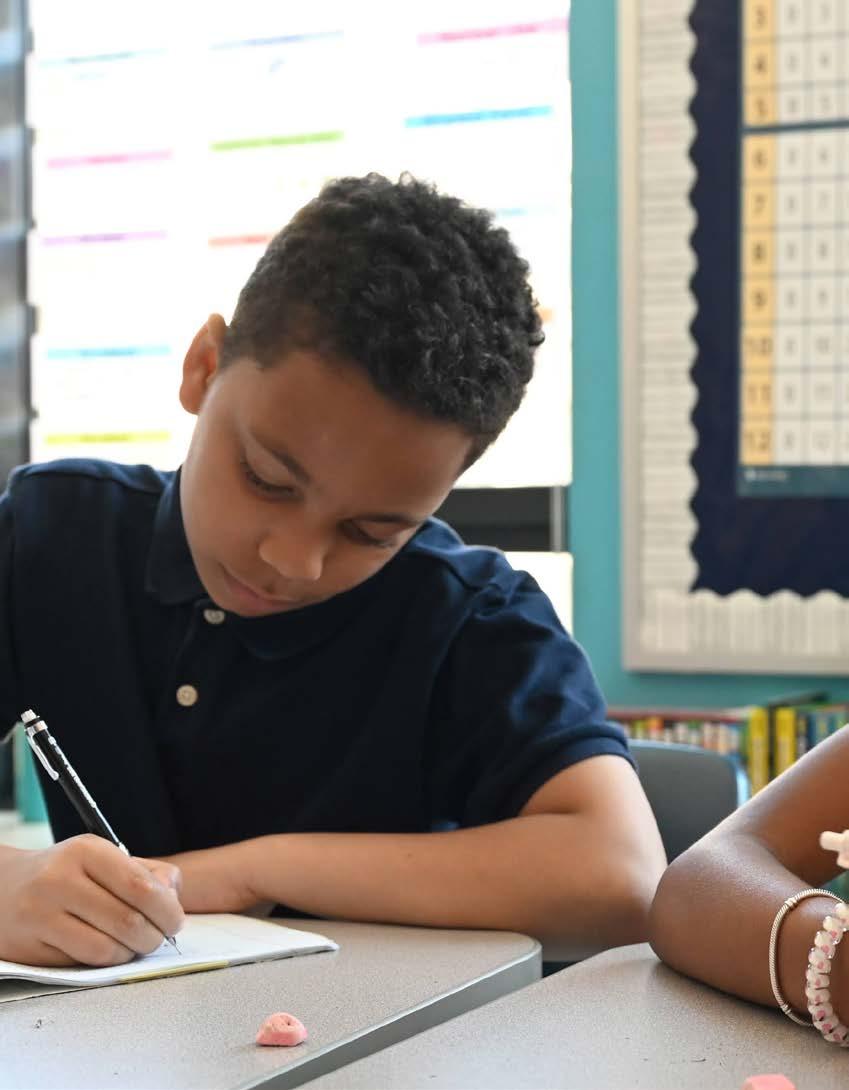
Through hands-on inquiry, students gather and analyze evidence and explore real-world challenges.
Third graders investigate how balanced and unbalanced forces affect motion, developing models to explain these interactions. They explore how traits are inherited and influenced by environments, analyzing variation within and across species and how traits impact an organism's ability to thrive. During a study of weather and climate, students collect data, analyze patterns, and design solutions to reduce the impact of natural hazards.
Fourth graders explore how energy is transferred and transformed within systems and consider ways to improve
I love that my son feels safe and comfortable in his school –challenged in many ways but also knowing exactly who to go to if ever in need of help.”
Parent ’29 - Anonymous Survey
reliability. Students then learn how light travels and is processed by different organisms. In a unit on Earth’s features, they study rock layers, fossils, and landforms to infer geological processes. During a unit on sound and waves, students explore how energy and information travel and ways sensory input helps organisms survive.
Fifth graders study the sun, moon, and stars to understand Earth's place in the solar system. Students then examine matter’s structure and properties and explore substance interactions. They study climate and water cycles and design ways to conserve resources. An ecosystem restoration unit focuses on organism relationships and strategies to improve ecosystem health.
In middle school, students write and perform original poetry, learn emergency year study of U.S. history with a trip to our longer-term assignments, navigate multiple leave middle school prepared for success in
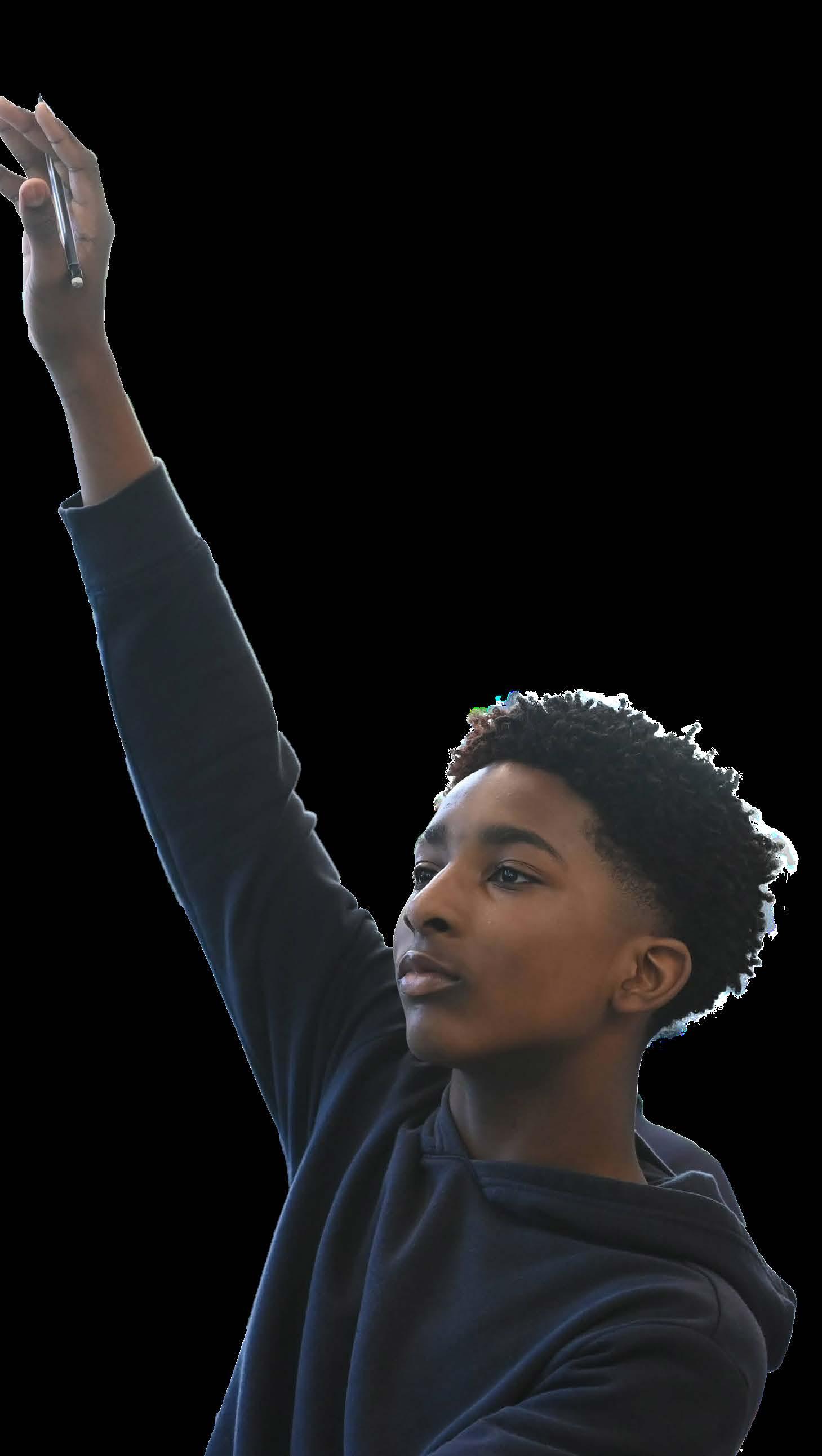
Blake’s Schedule | Eighth Grade Winter
Students can arrive as early as 7:15 a.m. and may stay until 5:45 p.m., with required programming from 8:30 a.m. until 4:10 p.m.
Classes
Arrives early for optional breakfast and time in the library
Algebra with advanced problem solving lab
English
Recess
Lunch
U.S. history (1865-present)
Applied science
Advisory: Team block (3x per week)
Advisory: Grade block (3x per week)
PE | Fencing (1x/week)
Community meeting (1x/week)
Skills seminar (1x/week)
Visual arts | Painting (1x/week)
After-School Enrichment
School musical
STEM club

Embraces outdoor challenges and bonds with classmates during our three-night overnight wilderness trip

Can run interscholastic cross-country at Van Cortlandt Park
Collaborates with classmates to design a daylong field trip to explore NYC
Performs in our annual eighth grade Shakespeare play
Participates in our Blazer Ceremony as an eighth grader, representing leadership both in and out of school
Explores D.C. and meets with national leaders during a three-day trip
Shares how a classmate exemplifies the School Creed during the graduation ceremony
Middle schoolers explore contemporary and classic literature, refine their writing across genres, and develop an expansive academic vocabulary. With each text, students analyze the motivations behind characters’ actions and reflect on how those choices relate to their own beliefs and values. Literature serves as both a mirror – helping students explore their identities and values –and a window into different times, places, and cultures. Writing plays a key role in deepening comprehension, encouraging students to clarify and extend their ideas about what they are reading and their personal stories.
Sixth graders begin the year reinforcing habits and strategies of good readers, analyzing how authors develop ideas over the course of a text. They explore short stories, write and perform original poetry, and develop literary analysis skills through constructed responses. In partnership with the Classical Theatre of Harlem, students prepare a scene from “A Midsummer Night’s Dream” to launch their Shakespeare unit.
Core texts include:
“Before We Were Free” by Julia Alvarez
“The Outsiders” by S. E. Hinton
“Brown Girl Dreaming” by Jacqueline Woodson
“A Midsummer Night’s Dream” by William Shakespeare
Seventh graders develop their voices through literary analysis and storytelling. They are introduced to a tool called “LASA” (literary analysis short answer), which serves as the foundation for more complex literary analysis essays moving forward. Through classic and contemporary novels and science fiction short stories, students explore timeless themes – particularly identity and integrity – as they emerge into early adolescence.
Core texts include:
“The Wanderings of Odysseus: The Story of the Odyssey” by Rosemary Sutcliff
“Bronx Masquerade” by Nikki Grimes
“A Raisin in the Sun” by Lorraine Hansberry
“Animal Farm” by George Orwell
Eighth graders apply their accumulated skills throughout the year, crafting and presenting original works of poetry, engaging in advanced literary analysis, and exploring Shakespeare through performance. In partnership with the Classical Theatre of Harlem, they work with visiting actors to analyze Shakespeare’s use of language to express character, plot, and theme. They end the unit with a performance of “Much Ado About Nothing,” “Macbeth,” or “Julius Caesar.”
Core texts include:
“The House on Mango Street” by Sandra Cisneros
“Claudette Colvin: Twice Toward Justice” by Phillip Hoose
“To Kill a Mockingbird” by Harper Lee
“Romeo and Juliet" by William Shakespeare
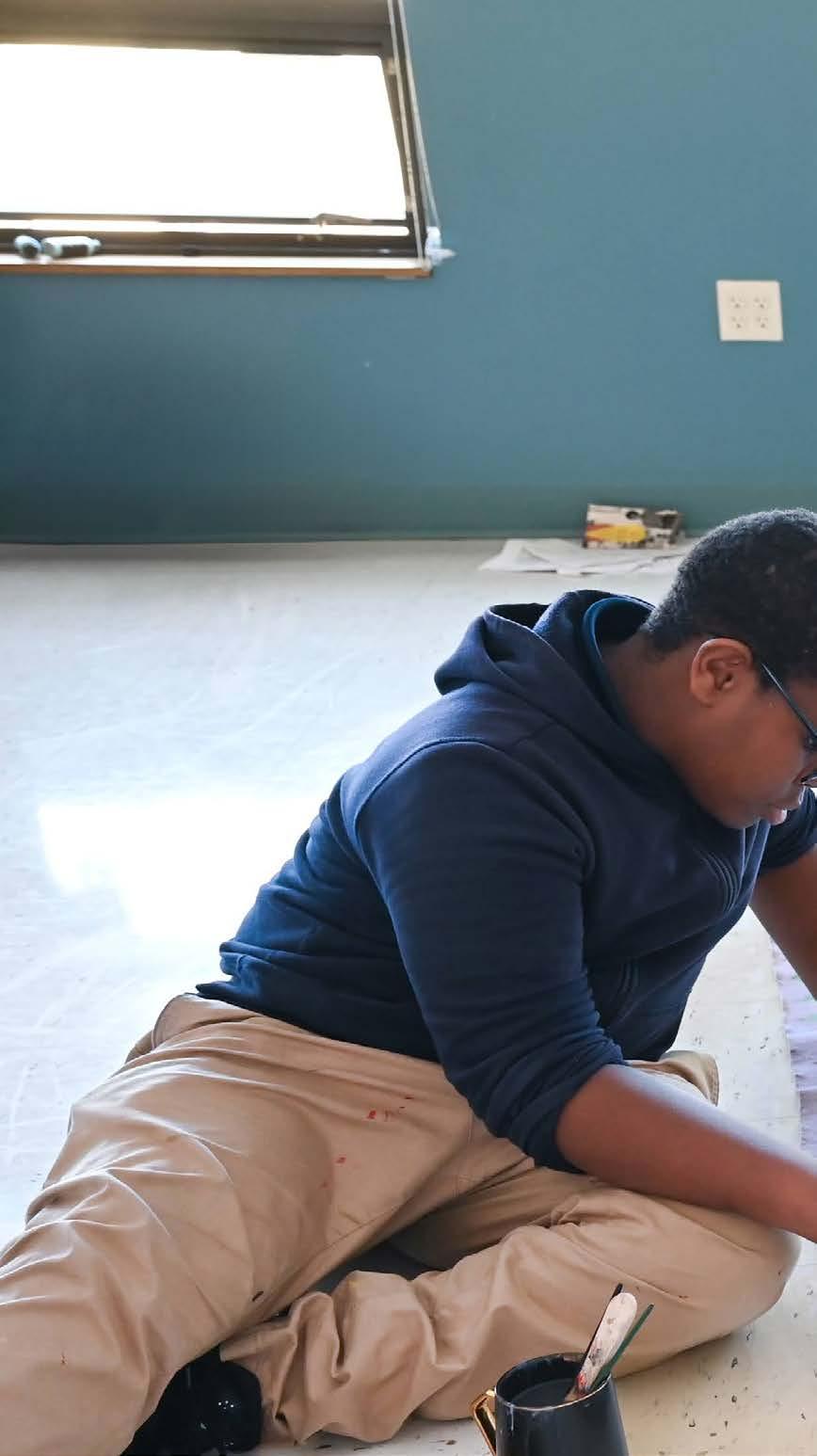
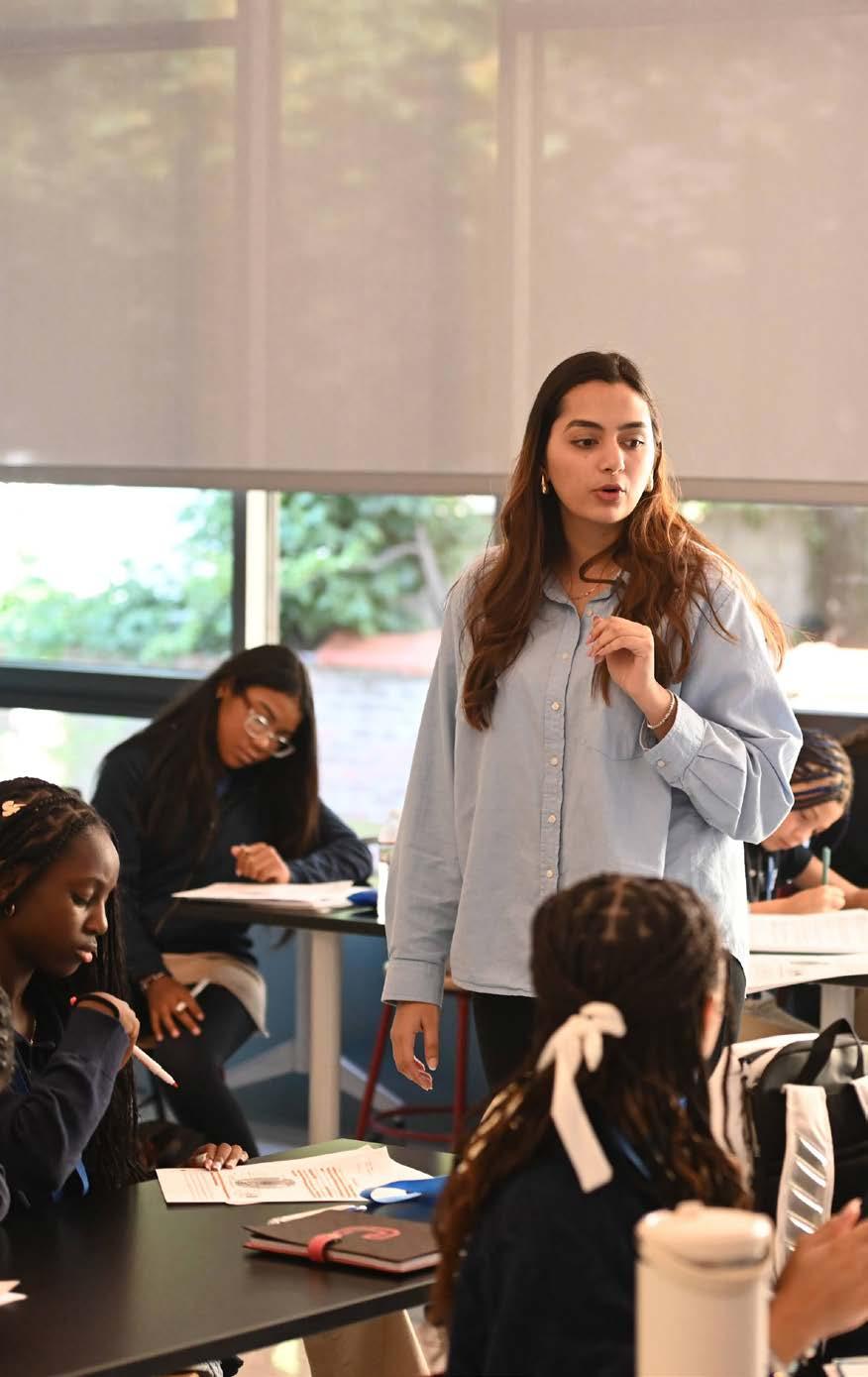

Students continue to develop as mathematicians throughout middle school, ultimately completing Algebra 1 in eighth grade. Our program builds students’ ability to articulate their reasoning clearly and critique mathematical arguments respectfully. Students ready for additional challenge are invited to join an advanced problem solving lab.
Sixth graders start the year exploring positive and negative integers along with number theory concepts, including prime numbers, factors and multiples, and squares and cubes. They develop a strong foundation in ratios, rates, unit rates, and speed-distance problems. Students represent percents as fractions and decimals and use models to solve problems involving percents. As they enter pre-algebra, they learn to represent unknown quantities with variables, simplify and solve one-step equations and inequalities, and explore independent
and dependent variables by graphing points on the coordinate plane. In the geometry unit, students calculate the area of polygons and the surface area and volume of rectangular prisms. Students also learn to describe the central tendencies of data sets using mean, median, and mode.
Seventh grade begins with a study of real numbers, classifying rational and irrational numbers, and gaining fluency with all four integer operations. Students build on their pre-algebra skills to solve multi-step equations and inequalities. They complete an in-depth study of linear equations, including calculating slope, graphing using slope-intercept form, and finding the equation of a line. Students are introduced to the concept of a function and identify functions and relations. Students also understand exponents as repeated multiplication and use exponent rules to multiply exponents with the same
base. Finally, students are introduced to simple and compound probability and develop probability models for different scenarios.
Eighth graders complete a high school level Algebra 1 course, beginning with a review of linear equations and inequalities before moving on to solving systems of equations. They extend their algebraic skills with exponent operations, polynomial arithmetic, and an in-depth study of factoring techniques. Students also explore quadratic equations, learning to graph parabolas and solve projectile motion problems using quadratic functions and graphs. Students explore rational expressions and equations and explore what values make a rational equation undefined. The year concludes with a unit on the Pythagorean theorem and special right triangles.
Our program centers on engaging academic content with regular connections between scientific concepts and future career paths. By integrating scientific reading, writing, and research, we prepare students to pursue higher-level science as they progress into high school and college.
Sixth graders act as geologists investigating fossils from different continents and learn how Earth’s surface changes over time. They apply their knowledge of plate motion as engineering interns tasked with designing a tsunami warning system. In astronomy, students explore moon features, phases, and eclipses. They then examine how temperature, wind, and energy transfer shape local weather and investigate climate change. Acting as civil engineering interns, they design roof modifications to reduce the climate impact of cities.
Our seventh grade human biology course is divided into two units: cells and human body systems. In the cells unit, students trace how DNA drives anatomy and physiology. Students look at different types of cells under the microscope and conduct several labs to understand how cells function. During the second unit, students study many of the organ systems that work together to help the body function.
Eighth grade applied science begins with emergency medicine, which connects students’ knowledge of body systems from seventh grade to the appropriate response to medical emergencies. Students analyze a patient to determine the injury and study first-aid responses to wounds, fractures, shock, and heat-induced illnesses. A lab-driven chemistry unit culminates in students designing, conducting, and documenting their own experiments. The year ends with an architecture unit, where professional architects guide students in designing and building a model structure. Students also work in our hydroponics lab, harvesting herbs and vegetables as part of their study of sustainability and urban farming.
My child has grown so much academically since she has been at Harlem Academy. The school is nurturing, supportive, and challenging. The staff really cares about the students, and it shows in all that they do.”
Victoria Allen, Parent ’25
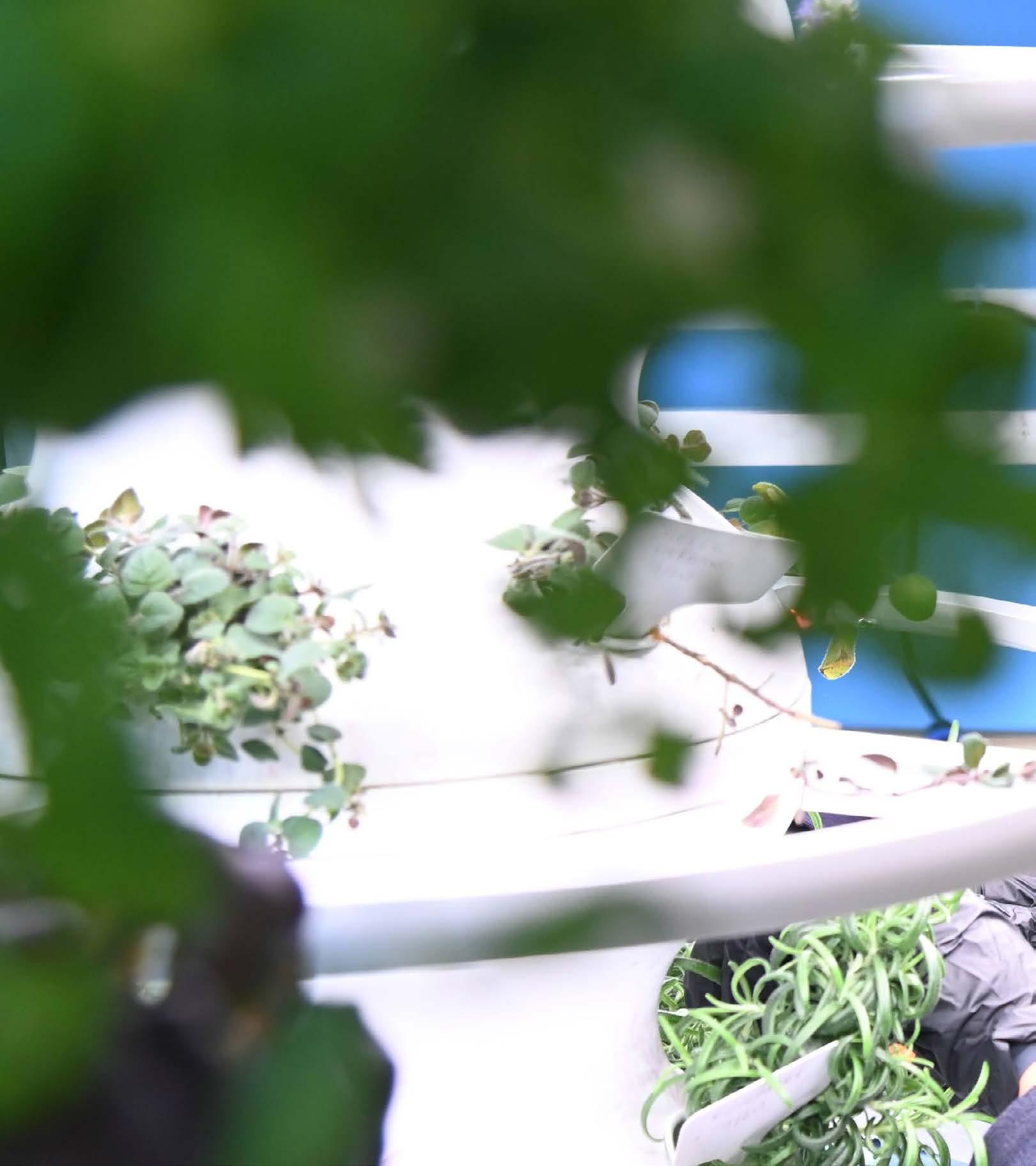
Middle schoolers learn to think like historians by developing essential analytical skills and building critical content knowledge. Students use evidence to construct and evaluate historical arguments, analyze primary and secondary sources to assess perspective and context, and examine continuity and change over time across cultures and regions.
Sixth grade world history focuses on the interactions between and within different societies from roughly 600 to 1800 C.E. The first unit focuses on the rise and spread of Islam and introduces the forces that unify societies and the ways empires develop, which are recurring concepts throughout the year. During the unit on West Africa, students read excerpts from a transcription
and translation of “Sundiata: An Epic of Old Mali” to examine how griots have preserved the history of the founding of the Mali Empire. The unit on Mesoamerica and South America includes our first “documentbased question,” where students are challenged to analyze a historical issue or trend through the lens of provided sources to serve as evidence. The final unit on interactions between societies of the Atlantic world from about 1450-1800 concludes with students using the content and skills they have learned to write interpretations of what fueled the Haitian Revolution.
Seventh graders launch a two-year study of U.S. history with Ronald Takaki’s “A Different Mirror for Young People: A History of Multicultural

America” as an anchor text. Takaki’s narrative invites students to consider how America's diverse population has experienced and remembers U.S. history from colonization to the present. Students then delve deeply into key events through 1865, beginning with the American Revolution and its varied meanings for different groups, followed by an exploration of the creation and content of the Constitution. The year concludes with a study of the Civil War, examining its long-term and immediate causes and the complex forces that led to the end of slavery.
Eighth graders investigate U.S. history from 1865 to the present, examining how Americans simultaneously pushed to expand freedom and resisted those efforts both within the country
and beyond. The year begins with an examination of Black Americans’ experiences in the decades following the Civil War, drawing on a mix of primary and secondary sources. Students then complete a research project using the resources of the New York Public Library to investigate a topic studied in the first unit and then formally present their findings. The course concludes with a focus on U.S. history in a global context, including a study of World War II, the Cold War, the Civil Rights Movement, and the causes and consequences of the 9/11 terrorist attacks. Students enter high school with an understanding and appreciation of the ways that historical narratives are constructed and can change over time.
Led by our middle school director, this weekly seminar equips students with effective study strategies, critical thinking skills, and strong academic foundations based on the science of learning. The course focuses on strengthening grammar skills and expanding academic vocabulary through etymology and morphology, helping students recognize word roots, prefixes, and suffixes to enhance comprehension. Students also develop research and information literacy, including how to find, evaluate, and cite reliable sources – a crucial skill for high school and beyond. In eighth grade, we incorporate secondary school placement test preparation, providing targeted practice and strategies for success on admissions exams.

Ask a Harlem Academy student about their day, and you’ll get more than just a list of classes. They might excitedly describe an upcoming improvisational theater performance, tap out a rhythm they mastered in percussion, show off a sculpture in progress, demonstrate new tennis strokes, or share a teambuilding challenge they took on in advisory.

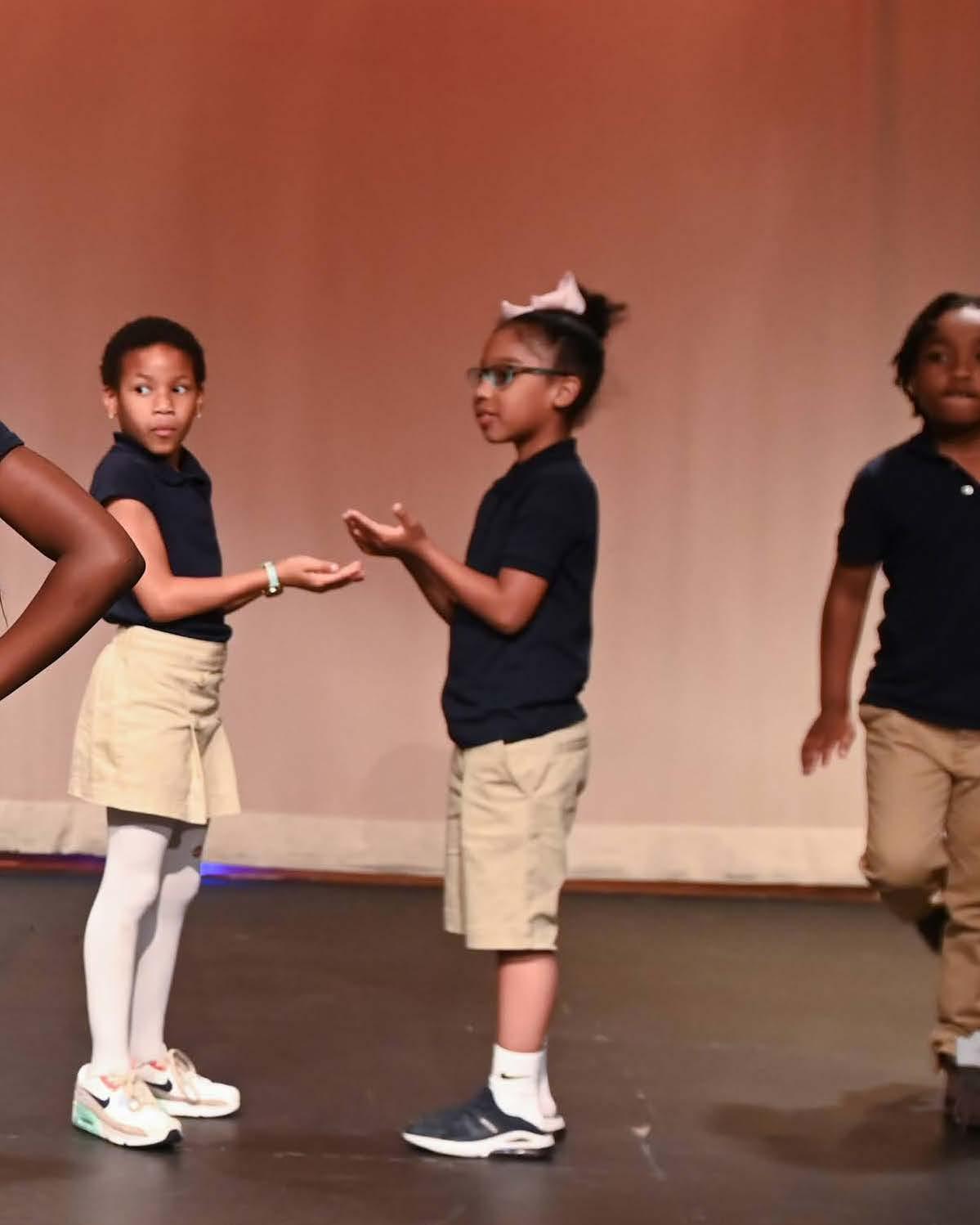
My
child loved the musical as it allowed them to dive deeper into a project, get comfortable on stage, and get to know their classmates better.”
Parent ’25 - Anonymous Survey
We guide students in developing foundational skills across arts disciplines, discovering new interests, and experiencing the joy of creating art. In partnership with our neighbor, Harlem School of the Arts, students learn from professional teaching artists in specialized dance, theater, music, and art studios. Throughout the year, showcases provide opportunities for families to celebrate their children’s artistic growth.
Students in second through fifth grade also engage in an in-depth exploration of works at the Metropolitan Museum of Art. They first discuss a range of pieces in the classroom before seeing them firsthand during museum visits, deepening their understanding and appreciation of the arts.

Chess at Harlem Academy is more than a game. It’s a dynamic tool for developing critical thinking, confidence, and personal development. With instruction woven into the weekly program for kindergarten through fifth grade, our vibrant chess culture fosters strategic thinking and perseverance. Through interactive lessons, students progress from learning the basic rules and piece movements to mastering more advanced strategies and techniques. Every student receives a subscription to ChessKid, an online platform that allows them to practice independently and sharpen their skills beyond the classroom.

Our comprehensive K-8 curriculum develops the knowledge and skills to make healthy choices and develop positive habits. Core areas of focus include emotional and mental health; personal health and wellness; safety, injury, and violence prevention; food and nutrition; physical activity; alcohol, drug, and tobacco prevention; and healthy relationships, growth and development, and sexual health (starting in fifth grade). Beyond understanding key health concepts, students develop essential skills around goal setting, decisionmaking, accessing information, analyzing influences, interpersonal communication, and self-advocacy.
Physical education at Harlem Academy builds motor skills and fitness as well as confidence, teamwork, and perseverance. Younger students have frequent opportunities for exercise, while older students refine their skills through more in-depth training.
Primary students participate in daily 35-minute sessions, while elementary and middle school students have longer sessions throughout the week. The curriculum introduces a variety of exercises and activities, with each trimester dedicated to a specific sport: tennis in the fall, fencing in the winter, and soccer in the spring.
Our advisory program guides students in building meaningful connections, developing social-emotional skills, and creating a personal understanding of how our School Creed connects to their daily decisions and aspirations.
For primary and elementary students, the day begins with a morning meeting, where students greet one another, share with the group, listen to others, and practice mindfulness. The day ends with a closing circle to reflect on what they’ve learned, celebrate achievements, share commendations, and say goodbye. These daily traditions instill a sense of accomplishment and belonging.
In middle school, students meet in grade-level groups to develop practical skills, such as time management and organization. For our oldest students, advisory also focuses on secondary school placement and special initiatives designed to prepare them for the increasing independence and responsibilities of their next academic chapter.
Eighth graders participate in our signature “High School Week” program, which simulates a high school environment with free periods, open campus privileges, increased academic demands, and less support. It is a chance for students to learn where they may struggle and develop strategies for managing increased independence.
In addition to grade-level advisory, middle school students meet three times per week in multi-age groups. They follow a three-year curriculum developed in-house that maps social and emotional learning concepts to the School Creed and pillars. Students also use this time for mindfulness, reflection, and preparing for annual middle school trips. Multi-age groupings foster community by building near-peer relationships, with younger students gaining confidence through friendships with older students and older students taking on leadership and mentorship roles.
Authors, researchers, scientists, architects, entrepreneurs, and other professionals regularly visit classrooms to bring real world perspectives and experiences. Faculty also make use of New York City’s rich cultural and academic institutions as an extension of our classrooms. In the spring, middle school advisory groups participate in our signature (Re)Explore program, which challenges students to plan a field trip. Working within a budget and schedule, students design a full-day itinerary that includes visiting two boroughs, exploring an iconic landmark, studying an exhibit in a cultural institution, and sampling diverse cuisines. This project deepens social-emotional competencies as students collaborate to research, plan, and ultimately take the trip.
With an extended day until 5:45 p.m., students engage in a variety of extracurricular activities.
Whether discovering a hidden talent or deepening an existing skill, students continue learning long after the final bell rings. The program grows with our students –starting with a choice block in kindergarten, expanding to a different option every day by second grade, and offering multiple choices each day in middle school.
Chess is part of our core curriculum for students in kindergarten through fifth grade, but opportunities don’t stop there. Students at all grade levels can join the chess team, where they receive tailored instruction based on skill and age and compete in matches with their peers. Team members put their skills to the test in weekend tournaments against other New York City schools, and the most dedicated players have the chance to compete in the state championship. These competitions help students learn to think ahead and approach each match with a strategic mindset - skills that serve students beyond the chessboard.
We encourage even our youngest learners to complete their homework independently. However, for all grades, teachers are available to answer questions and provide additional practice. The structured environment allows students to develop strong organization and time management skills, complete their work, and prepare for tests.
Students can meet with a mentor weekly for academic extension activities, such as writing, independent reading, and habit development. Mentors are thoughtfully assigned based on teacher recommendations and parent interest, providing students with individualized support to strengthen their academic foundation and holistic growth.
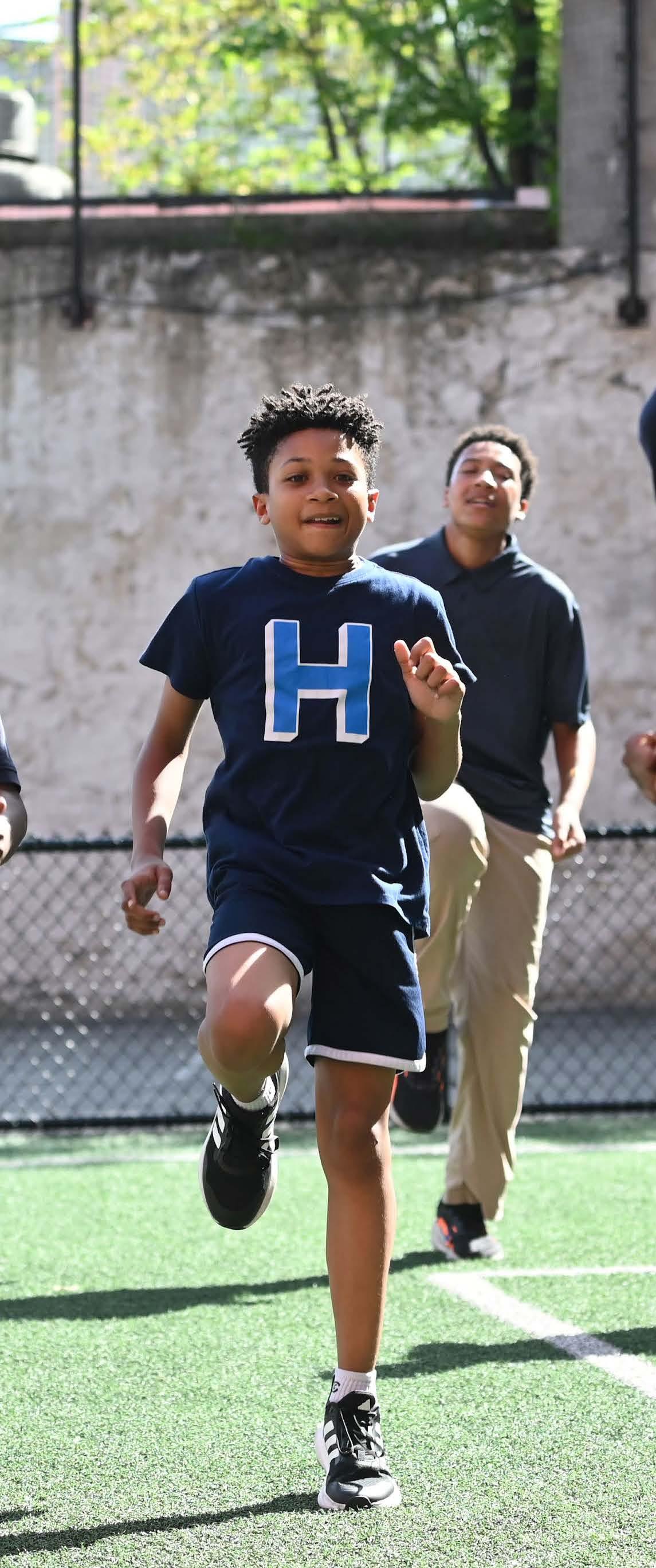
After completing their homework, students enjoy a choice block where they can engage in activities that spark their curiosity, creativity, and independence. Activities may include arts and crafts, mancala, chess, quiet reading, puzzles, or outdoor play.
Students participate in rotating enrichment activities led by full-time teachers.
Through interactive lessons, students in our Spanish enrichment explore traditions, celebrations, and notable figures from Spanish-speaking countries. This engaging approach builds an appreciation for cultural diversity and global perspectives while developing vocabulary, grammar, and conversational skills.
In our STEM enrichment, students dive into hands-on projects that fuel their curiosity. This program advances problem-solving, innovation, and collaboration –essential skills for future scientists and engineers.
Our art enrichment nurtures creativity through guided projects in drawing, painting, mixed media, and music. Budding artists develop confidence, imaginative thinking, and an appreciation for the arts as they explore color, texture, and composition.
Students stay active and learn sportsmanship and communication through board games, structured challenges, and sports. This program builds camaraderie, discipline, perseverance, and communication skills in a fun and engaging environment.

The middle school schedule offers flexibility, allowing students to pursue their interests and goals with guidance from advisors in making choices that advance academic and personal growth.
In the fall, our interscholastic cross-country team competes against other independent schools in a series of meets at the historic Van Cortlandt Park course. In the spring, our interscholastic track team competes in a variety of events, including sprints, distance runs, hurdles, shot put, and long jump.
Our theater club stages a winter musical, offering experience in both performing and behind-the-scenes set design. Students rehearse three times per week, building confidence and collaboration.
Our STEM club allows students to tackle real-world problems using trial and error, simple machine-building, and basic engineering principles. Our goal is to spark students’ intellectual curiosity by demonstrating that science is not an abstract set of concepts to memorize but an active process.
Our Spanish club allows middle schoolers to develop basic vocabulary, grammar, and real-world conversational skills through engaging topics and independent practice.
Our literary magazine club curates and publishes student poetry, stories, and photography. Each issue centers on a theme, challenging students to present their peers’ creative work in thoughtful and visually striking ways. Students gain experience in editing, design, and collaboration as they bring each edition to life.
My children love STEM days for the great experiments they get to do and arts days when they can show off their creativity.”
Lena Amanquah, Parent ’28 & ’29

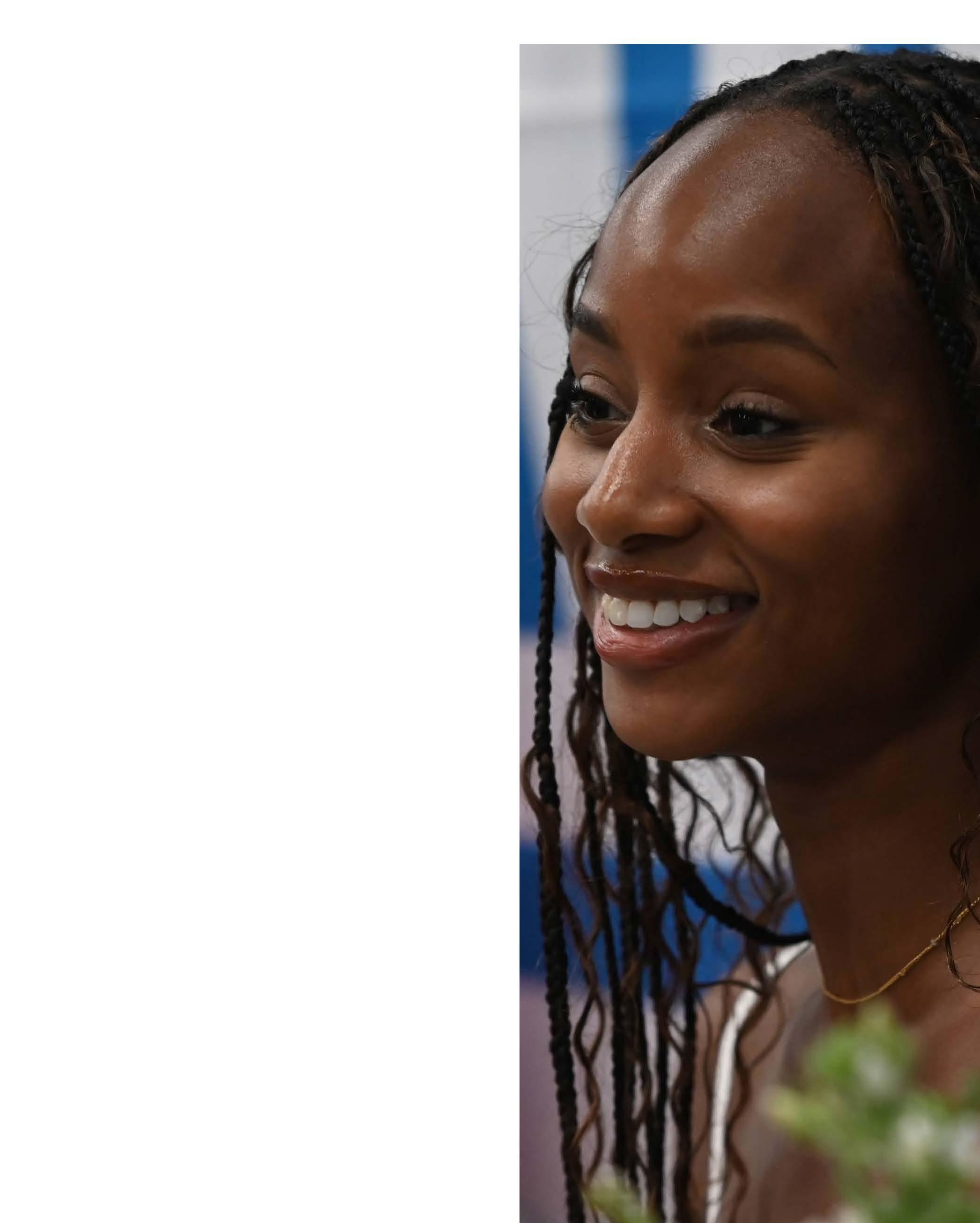

So much of my success can be tied to HA. I not only have a strong academic foundation that guided me through high school and college but also a strong initiative and engaging in self-reflection are second nature now and often guide my growth as I reach new

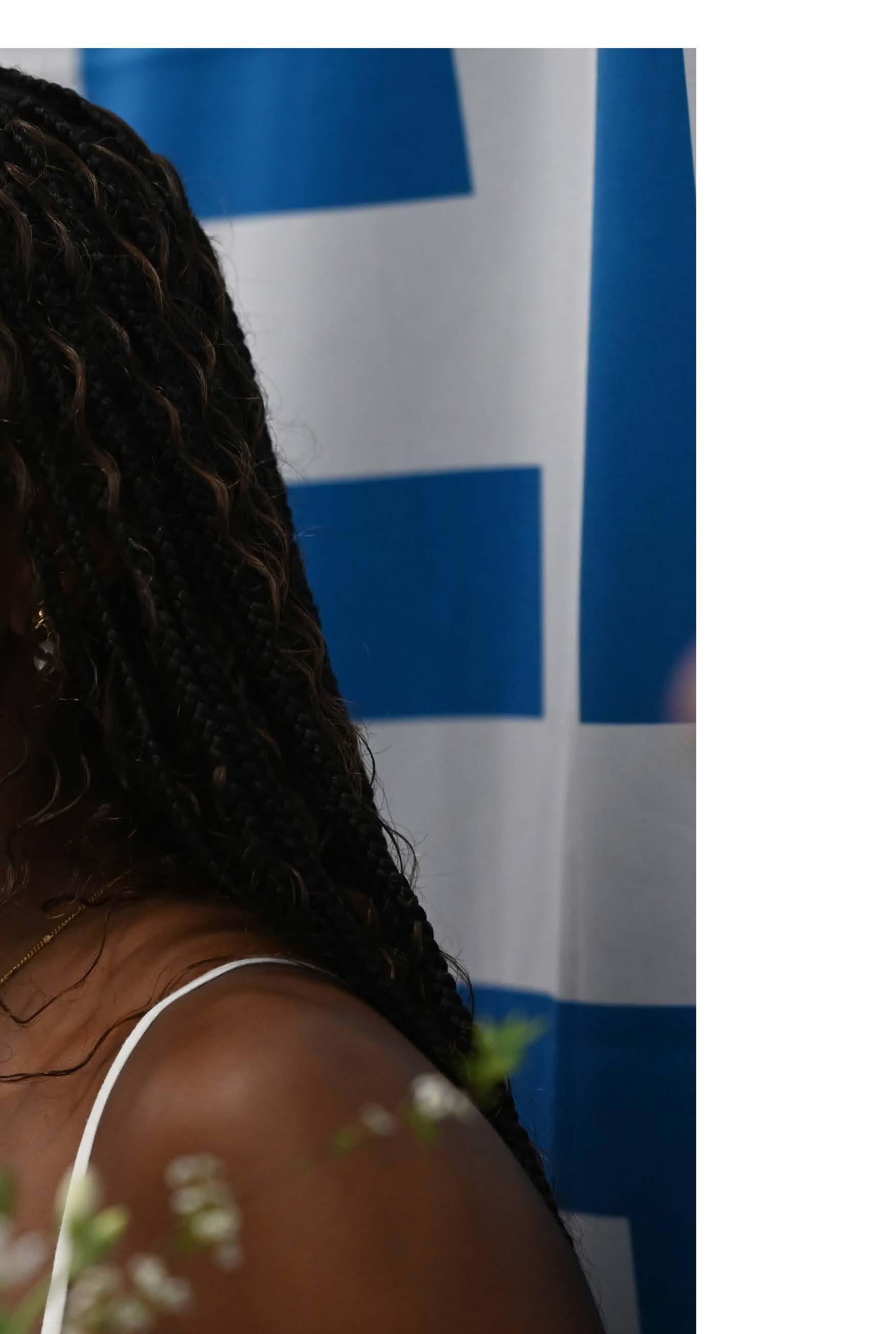
We advise and support our students as they consider their futures beyond Harlem Academy. Our goal at every stage is for each individual to nurture their talents, define their goals, and ultimately write their own, unique story.
At Harlem Academy, secondary school placement is a three-year partnership starting in sixth grade with the premise that admission to and success at a top secondary school is a shared responsibility among students, parents, and the school. Our goal is to ensure that every student is placed in a school that will challenge and support them in their continued academic and personal growth.
Our process includes group meetings to introduce different secondary school models and the admission process for each. Individual conferences help students refine their choices and set personal and academic goals to maximize their options. As students identify potential schools, our approach is radically transparent, grounded in the belief that students make the best decisions when they fully understand how their choices shape their opportunities. Our high school fair offers a wonderful opportunity for middle schoolers to meet with representatives from more than 40 high schools before we open the doors to the public.
The commitment that makes students strong members of Harlem Academy's community also makes them competitive applicants to selective high schools. That's why we continue to prioritize
both academic excellence and each student's holistic development. To supplement this, we begin standardized test preparation in seventh grade, providing access to Test Innovators for practice exams, real-time feedback, and targeted skillbuilding. In eighth grade, preparation continues through our skills seminar and a tutoring partnership with ArborBridge.
Interview preparation and essay development are important components of our secondary school placement program. Seventh and eighth graders learn to share their stories and thoughtful selfreflections through classroom instruction and practice sessions with trained volunteers. In eighth grade, students work with their English teacher throughout the fall to craft personal statements and supplementary essays.
We assist with transportation for school tours and interviews, helping students explore their options and find the best fit.
Our team offers comprehensive support throughout the application and financial aid process, ensuring families have the guidance to navigate deadlines, submit materials, and make informed decisions.

Andover
Columbia
Friends
Lawrenceville
Riverdale
Sacred
Spence
Trevor
Westover

With nearly 200 members and growing, our alumni pursue diverse paths but remain bound by a commitment to making a mark on the world. We strive to be a lifelong resource long after graduation, supporting alumni through high school, college, and into careers.
We check in regularly to share updates, celebrate achievements, and collaborate on challenges and new opportunities.
We offer support throughout the college application process, including developing a strong school list, preparing for standardized tests through our partners at ArborBridge, and crafting personal statements. Beyond college, we assist with finding internship and job opportunities to help alumni launch and grow their careers.
At our annual Homecoming event, graduates welcome eighth graders into the alumni network and celebrate high school and college seniors as they take their next steps.
Many alumni return to support the next generation – whether speaking in classrooms, mentoring students, or serving on our junior board. It’s a fullcircle representation of meeting our mission: for students to thrive at the highest academic level and make their mark on the world!
48 zip codes

58
average class size acceptance rate countries where our families have roots
square-foot building
1/2 acre campus
27 Celebrations of Learning, allowing students ample opportunity to practice public speaking
98 earn scholarships to independent secondary schools alumni have returned to join our team
7
23
11 states countries where alumni studied during college % matriculate to four-year colleges and universities
INITIATIVE
I am bold and creative. I take opportunities to lead. I seek help when I need it.
INTEGRITY
I am honest and reflective. I choose to do what is right, Even when it is hard or no one is watching.
COMPASSION
I listen carefully. I speak kindly. I care for my community.
DETERMINATION
I make the most of each day. I learn from my mistakes. I don’t give up.